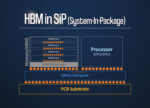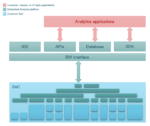GenAI, the most talked-about manifestation of AI these days, imposes two tough constraints on a hardware platform. First, it demands massive memory to serve large language model with billions of parameters. Feasible in principle for a processor plus big DRAM off-chip and perhaps for some inference applications but too slow … Read More
Tag: hbm
2024 Outlook with Srinivasa Kakumanu of MosChip
MosChip is a publicly traded company founded in the year 1999, they offer semiconductor design services, turnkey ASIC, software services, and end-to-end product engineering solutions. The company headquartered in Hyderabad, India, with five design centers and over 1300 engineers located in Silicon Valley (USA), Hyderabad,… Read More
Accelerate AI Performance with 9G+ HBM3 System Solutions
In the technology realm of artificial intelligence (AI) and high-performance computing (HPC), the demand for higher throughput and efficiency has never been greater. To meet these evolving demands, innovative memory solutions have emerged as critical enablers, paving the way for transformative advancements in computing… Read More
AMAT – Flattish QTR Flattish Guide – Improving 2024 – Memory and Logic up, ICAPs Down
– AMAT slightly better than expected, flat & guides flat but > expected
– Expects better 2024- Systems flat, service up, display down
– China risk remains high at 45%- $200M Sculpta expected in 2024
– HBM 5% of industry but not a lot of tool sales- but high growth
Still bumping along with flattish … Read More
LRCX- In line Q4 & flat guide- No recovery yet- China still 40%- Lags Litho
– Lam reported as expected and guided flat- No recovery yet
– Some mix shifts but China still 40% (8X US at 5%)-NVM still low
– HBM is promising but Lam needs a broad memory recovery
– Lam has not seen order surge ASML saw- Likely lagging by 3-4 QTRs
An in line quarter and uninspiring flat guide for Q1
As compared… Read More
SEMICON West 2023 Summary – No recovery in sight – Next Year?
-SEMICON well attended but bouncing along the biz bottom
-Recovery seems at least a year away with memory even more
-AI creates hope but not impactful- Disconnect tween stocks & reality
-AMAT me too platform- Back end benefits from chiplets
SEMICON busy but subdued
SEMICON is certainly back to pre-covid levels or perhaps better.… Read More
Three Ways to Meet Manufacturing Rules in Advanced Package Designs
Often designers are amazed at the diversity of requirements fabricators and manufacturers have for metal filled areas in advanced package designs. Package fabricators and manufacturers do not like solid metal planes or large metal areas. Their strict metal fill requirements address two main issues. The dielectric and metal… Read More
Upcoming Webinar: 3DIC Design from Concept to Silicon
Multi-die design is not a new concept. It has been around for a long time and has evolved from 2D level integration on to 2.5D and then to full 3D level implementations. Multiple driving forces have led to this progression. Whether the forces are driven by market needs, product needs, manufacturing technology availability or EDA… Read More
Optimize AI Chips with Embedded Analytics
The foundry model, multi-source IP blocks, advanced packaging technologies, cloud computing, hyper-connectivity and access to open-source software have all contributed to the incredible electronics products of recent times. Along with this, the complexity of developing and taking a chip to market has also increased. And… Read More
Driving PPA Optimization Across the Cubic Space of 3D IC Silicon Stacks
The move to true 3D IC, monolithic 3D SOC and 3D heterogeneous integration may require one of the most major design tool architecture overhauls since IC design tools were first developed. While we have been taking steps toward 3DIC with 2.5D designs with interposers, HBM, etc., the fundamental tools and flows remain intact in many… Read More










